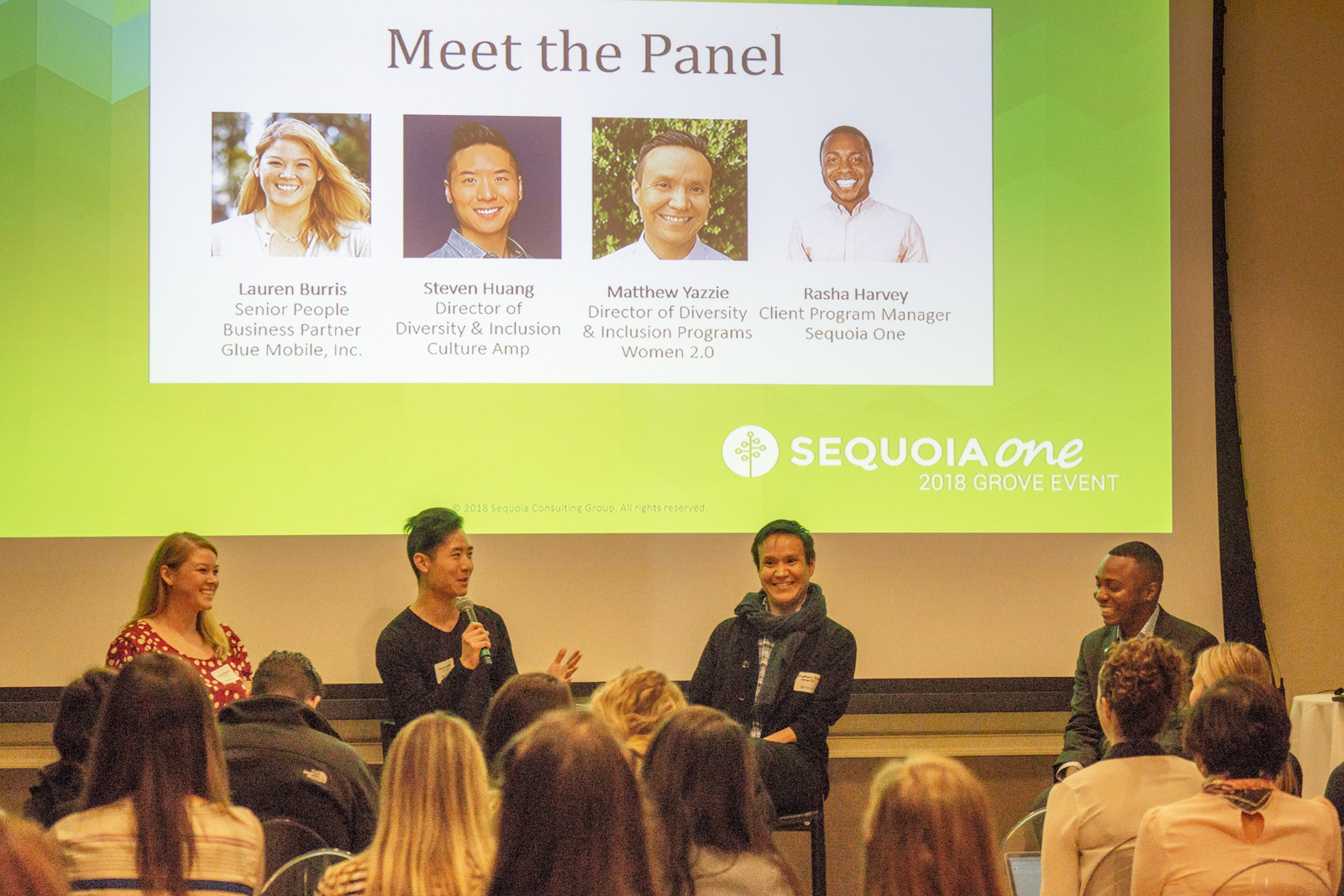Diversity and Inclusion (D&I), I cannot think of a more timely topic. I can safely say this was one of the most lively D&I sessions I have engaged with in recent memory. What a privilege it was to moderate our recent D&I session at our annual gathering dedicated to Bay Area start-ups, Sequoia One: The Grove 2018.
It is not surprising that many HR and Tech leaders have recently been charged with a diversity mandate from their executives. This session was full of healthy and much needed debate. We agreed we are making progress and that most tech companies are directionally on the right path. We also agreed that this cannot be a one department or an HR-only charter. The reality is that most companies are working to open up meaningful productive dialogue in their company. It is also clear that top executives need to play a role. I encourage all of you to continue to discuss this topic in your organizations. I truly believe it will create a lasting positive influence in your organizations. Read on to hear from the experts who have been at this a lot longer than most of us.
Panel:
Lauren Burris, Sr. People Business Partner, Glue Mobile, Inc.
Steven Huang, Director of Diversity Inclusion, Culture Amp
Matthew Yazzie, Director of Diversity & Inclusion Programs, Women 2.0
“It is a privilege for us in the HR field to address this topic. Although, we can’t move it along alone.”
— Rachel Marotto, HR Leader, Blockstream
What’s diversity and what’s inclusion?
As defined by Merriam Webster’s Dictionary:
- Diversity is defined as 1: the condition of having or being composed of differing elements: variety; especially: the inclusion of different types of people (such as people of different races or cultures) in a group or organization
- Inclusion is defined as 1: the act of including: the state of being included. 2: a relation between two classes that exists when all members of the first are also members of the second 3: the act or practice of including students with disabilities in regular school classes
I have shared the definitions above so that companies can determine for themselves if they are drinking their own champagne. The intent to include may be there, but in practice there may be more work to do. Ask yourselves by definition above if your company is diverse and truly inclusive. Also, does you workforce have the right tools to implement these practices culturally?
“Diversity without inclusion is a story of missed opportunities, of employees being so used to being overlooked that they no longer share ideas and insights. But diversity with inclusion provides a potent mix of talent retention and engagement.”
— Ripa Rashid, Harvard Business Review, “Diversity Doesn’t Stick Without Inclusion”
Where should diversity and inclusion be held?
Generally, we are seeing that this initiative sits with HR. They play a big role, although they should not be solely driving. We strongly encourage that the head of D&I have a direct line to the CEO or C-suite. One department or one person alone cannot own societal and company cultural issues. We also encourage annual or six month rotations of owners of a D&I initiative. D&I roles should be about aiding in bridging a gap.
Steps To Reach Your D&I Vision
There is no universally proven strategy for all companies, so test different strategies.
- Step 1: Identify and understand D&I data
- Step 2: Run an open discussion “Fish Bowl” to start the conversation
- Step 3: What is the tool or technology platform you have to promote D&I? Or can you promote D&I through your products? For example: Twitter is the platform for #metoo and #blacklives matter
- Step 3: Take care of yourself HR, sometimes these scenarios can be intense
- Step 4: Identify the company philosophy and ideology
- Step 5: Evaluate actionable D&I measurements for success
- Step 6: Leadership buy-in is crucial (e.g. a culture committee run by the C-suite)
- Step 7: Establish values early with D&I as a principle
- Step 8: Share the risk and share the belonging
Crisis
Things are going to happen, you are in HR. Think through the code of conduct and how it translates at all levels of the organization so people can tangibly grasp the policies. As important, ensure that there is a point of contact for clarity on any gray areas. We have all been there with those employees who stretch the policies. Clarification is crucial. Try to approach crisis scenarios with giving all parties the benefit of the doubt. Go back to the values of trust assuming the best intentions. Empathize and escalate appropriately.
Fatigue
This is real thing when it comes to D&I. The goal is to keep people engaged, but not go overboard. This can be difficult as you have legacy employees vs. new employees and there could be an Us vs. them mentality. You can bridge the gap and explain these are growing pains culturally. It is the growth vs. why we cannot stay the same syndrome. Try to have conversations like this on a 1:1 basis. Rotate your leadership team discussing these topics regularly (in an All Hands perhaps) and also evaluate short term quarterly projects that tie back to your core values. We will repeat again, dealing with systemic diversity issues is tough and continually encouraging leadership to support the initiative is essential.
Perspective
We are so privileged to be in a time where we can have this conversation. We have such an opportunity as we are a part of forward-thinking organizations that have the ability to shift and make change. Celebrate the wins with your team. Whenever people get fatigued, that is a privilege. Not everyone has that privilege.
We all know people who have had experiences where they felt excluded. Let us ask ourselves how we address these scenarios to evaluate policies so that does not happen again. We have to put these policies in place before we assume everyone is a social warrior. Look after the people who are most marginalized.
The bottom line is meet people where they are, do not take on any company culture policies alone, and be very clear. It is an interesting debate as to how concrete policies really are, right? Do not back track on policies, yet think about re-evaluating policies quarterly. Continue to evaluate the size of the company and keep connecting to policy for decreasing liability and risk. Let your CEO and leadership team guide you as to cultural development.
Now, you are poised to start the conversation and include everyone.
“We really aren’t going to make much progress until we have everyone engaged in the conversation, especially straight white men.”
— Matthew Yazzie, Director of Diversity & Inclusion Programs, Women 2.0
Want to learn more more best practices? Join the Sequoia Thought Leadership Series the last Wednesday of every month.




